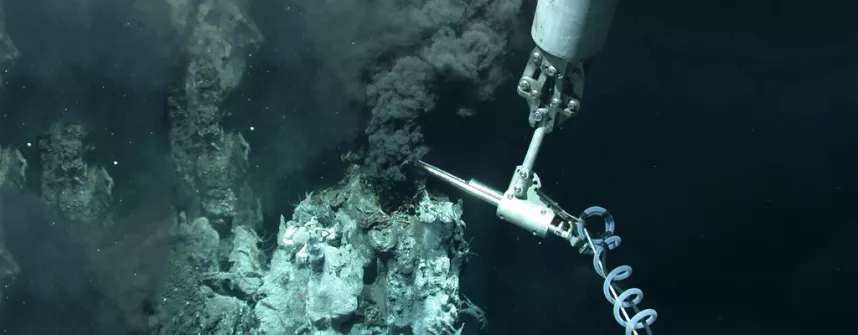,
January 11, 2017
It is one of the most active eruption zones in the world: Kermadec Ridge in the Pacific. An international group of scientists led by Professor Andrea Koschinsky, Professor of Geochemistry at Jacobs University, will study the geochemical and ecological effects of undersea volcanoes in this region. The interdisciplinary research project, in which eight partners are participating, is funded with more than 1,08 million Euro from the German Federal Ministry of Education and Research.
“The Kermadec Ridge, located north of New Zealand, is an undersea mountain range with dozens of volcanoes on the sea floor. The hot undersea springs sustain various forms of life; hundreds of meters below the surface of the water, ores of copper, zinc, lead, silver, and gold are formed. Andrea Koschinsky explains the central goal of the project: “We want to understand the complex overall system and the interactions among the living things in the undersea world, the hot springs, and the minerals.” For instance, the study will examine the importance of metals and trace elements, that rise as plumes of smoke from hot springs on the sea floor, for the metabolic processes in the sea. Just a few years ago, it was still assumed that the trace metals leaching out of the underground rock by the hot springs sank for the most part to the sea floor. Today it is known, for example, that the vital element iron can be transported from the hydrothermal springs for long distances, even reaching the water near the surface, and probably plays an important role in the formation of plankton. Shortly before Christmas, the scientists started their excursion on board the research ship “Sonne” in New Caledonia. Among other things, it is equipped with the unmanned deep-sea robot “Quest” from MARUM (University of Bremen), which is used in volcanoes at various water depths between 200 and 1600 meters. “We want to explore the influence of depth upon the hot solutions,” says Professor Koschinsky. The deep-sea robot will also bring samples of ore, rocks, and organisms on board. In order to examine changes in water composition, vertical sampling of water columns is planned. A water sampler will take samples from just above the sea floor up to the water surface. In addition to Jacobs University, five other German partners are taking part in the research project. They include the University of Bremen with the Center for Marine Environmental Science (MARUM), the Max Planck Institute for Marine Microbiology, as well as the Universities of Oldenburg, Hamburg, and Münster. Two groups of New Zealand scientists are also involved. The research voyage ends on January 21rd in New Zealand. It will be followed by a multi-year analysis phase. For up-to-date information about the excursion and vivid impressions from work and life on board the research ship, we recommend the following blog: http://geschichten.ptj.de/so253-en (English version) or http://geschichten.ptj.de/so253#74871 (German version) Additional information:http://akoschinsk.user.jacobs-university.de Questions will be answered by:Professor Andrea Koschinsky | Professor of Geosciencea.koschinsky [at] jacobs-university.de | Tel: +49 421 200-3567
,
Some impressions of the excursion
,
Fluid sampling of a White Smoker consisting of elemental sulfur with the deep-sea robot ROV Quest in the Macauley Caldera
(Source: MARUM, University of Bremen)
,
Mineral chimney and abundant life in a newly discovered hydrothermal vent field at the Haungaroa volcano
(Source: MARUM, University of Bremen)
,
The Remotely Operated Vehicle ROV Quest (MARUM) takes samples of fauna in a hydrothermally active field at the Haungaroa volcano
(Source: MARUM, University of Bremen)
,
The Remotely Operated Vehicle ROV Quest (MARUM)is recoverd after a 12-hour successful dive and delivers plenty of samples to the scientists for a long night in the laboratories of RV Sonne.
(Source: Marie Heidenreich, PTJ)
,
Chief scientist Prof. Andrea Koschinsky and her interdisciplinary and international science team are excited about the very successful cruise SO253.
(Source: Marie Heidenreich, PTJ)
,
The fluid geochemistry team of Jacobs University Bremen (Dr. Charlotte Kleint, student Nico Fröhberg and guest scientist Jan Hartmann) take water samples of the hydrothermal plume from the rosette water sampler.
(Source: Marie Heidenreich, PTJ)
,
Annika Moje, lab technician at Jacobs University Bremen, takes care of the fluid sampling system KIPS operated with the ROV Quest (MARUM).
(Source: Marie Heidenreich, PTJ)
